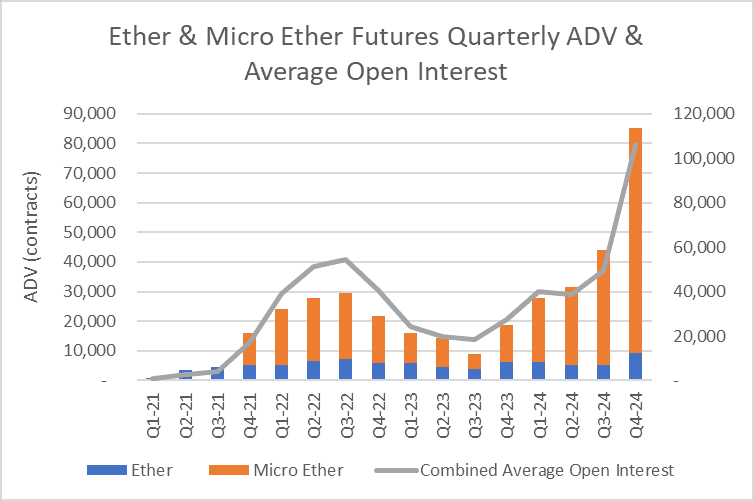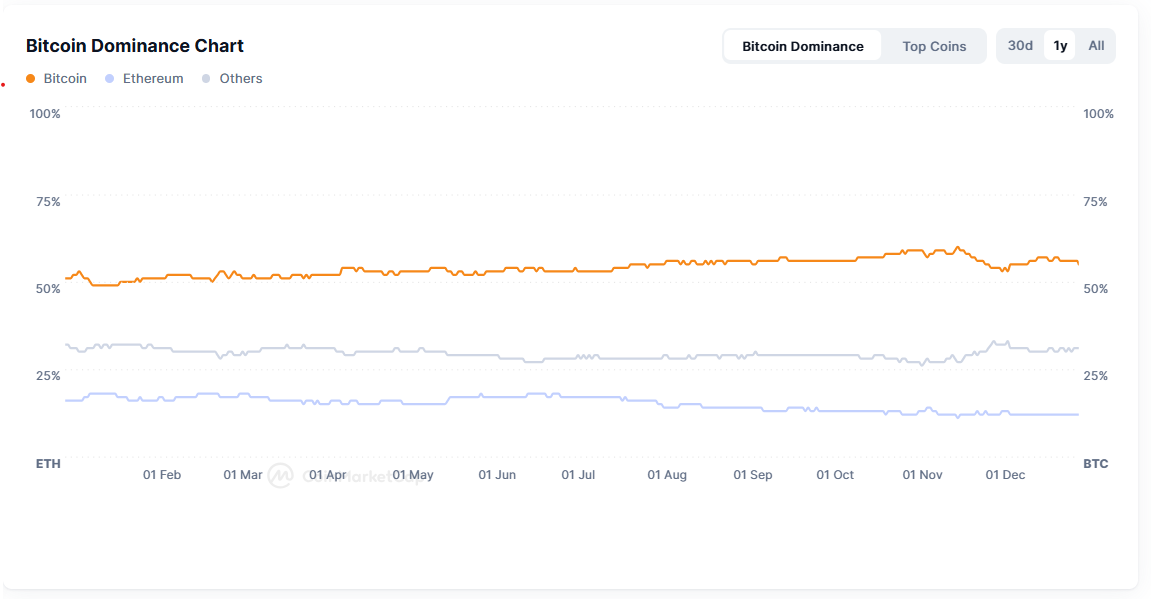Uncategorized
Why Ether Could Outperform Bitcoin in 2025

Ether spent most of 2024 trailing behind its cryptocurrency peers but has now firmly joined the rally sparked by bitcoin’s record-breaking climb, crossing the $4,000 mark in December but well below its all time high of $4,900.
In 2024, ether gained around 53% compared to bitcoin’s 113% surge; however, ether’s recent performance shows promise. Since the U.S. election result, ether has increased 39%, outperforming bitcoin’s 35% gain and signaling a potential resurgence driven by market optimism over president-elect Donald Trump’s anticipated pro-crypto policies.

Other key factors driving this optimism include robust staking dynamics, steady transaction fees and growing institutional interest, particularly through ETFs.
Ether futures
While the year started with muted volume, CME ether futures were the go-to product for risk management as spot ether ETFs began trading mid-year and volatility returned to the market toward year-end. In 2024, nearly 12 million contracts representing a total value of $256 billion traded between ether and micro ether futures. Thirty-nine percent of notional volume traded was transacted in Q4 2024 as the crypto markets reacted to the U.S. election results, signaling a buoyant sentiment.

Large open interest holders (designated by the CFTC as entities holding 25 or more contracts) reached new weekly records throughout December, indicating growing client interest in regulated solutions to manage ether risk.
Ether-bitcoin ratio
The ETH-BTC ratio, which measures ether’s performance relative to bitcoin and shows the number of bitcoin needed to buy one ether, reached its lowest level since launch on Nov 20 of 0.032857, which may be its bottom as we see improved regulatory outlook and an increase in institutional adoption.

What’s behind ether’s rebound
1. Ether ETFs outperform bitcoin ETFs
U.S. spot ETH ETFs have received a cumulative $577 million in net inflows since their July 2024 launch, an overall success among the broad ETF universe. Between November 25 and November 29, spot ether ETFs even surpassed the daily inflows of bitcoin ETFs, with ether ETFs experiencing a net inflow of $467 million (including net inflows of $428 million in a single day), marking a shift in investor sentiment.
The approval of both bitcoin and ether ETFs represents a major milestone in the mainstream adoption of digital assets. Looking ahead, the interest of institutional investors could rise even further if regulatory approval allows asset managers to incorporate Ethereum staking yields into ETFs.
2. Alt Season
After months of ether underperforming bitcoin, traders may now see the ETH/BTC ratio’s lower level as an opportunity with a potential gradual rotation from BTC to ETH and other alt coins.
Typically, bitcoin leads the rally, then consolidates as ether and other alt coins catch up. This has been true this cycle where bitcoin’s dominance dropped from 61.7% in October to 57.4% in November and to 56.5% in December, suggesting that altcoins may have begun gaining momentum for a potential alt season.

3. Staking yields
Ether investors can generate extra returns on top of their holdings by staking or locking their coins in the network in return for rewards. As of the time of writing, 28% of ether’s supply is locked in staking contracts with the annualized reward rate averaging 3%. Under a new administration, together with anticipated Federal Reserve interest rate cuts and continued upgrades to the blockchain, there could be an uptick in ETH’s staking yield.
4. DeFi, smart contracts, DAPPS and NFTs
Ethereum’s value proposition extends beyond being a digital currency, as it remains the dominant blockchain for building decentralized finance (DeFi) applications (DAPPS), smart contract platforms, NFT (non-fungible token) tokenized assets and Web3 applications.
The total value locked (TVL) in Ethereum-based DeFi projects has grown over the past few weeks, reaching $69.4 billion, according to DefiLlama. The surge suggests rising confidence in Ethereum as a platform for financial innovation.
5. Ether upgrades
On March 24, Ethereum implemented the Dencun upgrade, which reduced transaction costs for Layer 2’s and increased the Transactions per Second (TPS) at which they could post to the Layer 1. The adoption of Layer 2’s has shifted noticeably over the last year. In addition, the Pectra upgrade, expected in Q1 2025, is one of the largest hard forks ever in terms of the Ethereum Improvement Proposal (EIP) count. It aims to improve protocol efficiency, enhance the user experience and expand data capacity, as well as pave the way for future scalability enhancements.
Conclusion
All eyes are on what the Trump administration will bring and the implications for the entire crypto market. The growing interest of institutions in ether ETFs could signify a diversification of institutional portfolios, which were once largely focused on bitcoin. The possibility of staking rewards and ether’s central role in DeFi and NFT innovations in 2025 may bring even more demand for ether.
Uncategorized
What’s Next for Bitcoin and Ether as Downside Fears Ease Ahead of Fed Rate Cut?

Fears of a downside for bitcoin (BTC) and ether (ETH) have eased substantially, according to the latest options market data. However, the pace of the next upward move in these cryptocurrencies will largely hinge on the magnitude of the anticipated Fed rate cut scheduled for Sept. 17.
BTC’s seven-day call/put skew, which measures how implied volatility is distributed across calls versus puts expiring in a week, has recovered to nearly zero from the bearish 4% a week ago, according to data source Amberdata.
The 30- and 60-day option skews, though still slightly negative, have rebounded from last week’s lows, signaling a notable easing of downside fears. Ether’s options skew is exhibiting a similar pattern at the time of writing.
The skew shows the market’s directional bias, or the extent to which traders are more concerned about prices rising or falling. A positive skew suggests a bias towards calls or bullish option plays, while a negative reading indicates relatively higher demand for put options or downside protection.
The reset in options comes as bitcoin and ether prices see a renewed upswing in the lead-up to Wednesday’s Fed rate decision, where the central bank is widely expected to cut rates and lay the groundwork for additional easing over the coming months. BTC has gained over 4% to over $116,000 in seven days, with ether rising nearly 8% to $4,650, according to CoinDesk data.
What happens next largely depends on the size of the impending Fed rate cut. According to CME’s Fed funds futures, traders have priced in over 90% probability that the central bank will cut rates by 25 basis points (bps) to 4%-4.25%. But there is also a slight possibility of a jumbo 50 bps move.
BTC could go berserk in case the Fed delivers the surprise 50 bps move.
«A surprise 50 bps rate cut would be a massive +gamma BUY signal for ETH, SOL and BTC,» Greg Magadini, director of derivatives at Amberdata, said in an email. «Gold will go absolutely nuts as well.»
Note that the Deribit-listed SOL options already exhibit a strong bullish sentiment, with calls trading at 4-5 volatility premium to puts.
Magadini explained that if the decision comes in line with expectations for a 25 bps cut, then a continued calm «grind higher» for BTC looks likely. ETH, meanwhile, may take another week or so to retest all-time highs and convincingly trade above $5,000, he added.
Uncategorized
Asia Morning Briefing: Native Markets Wins Right to Issue USDH After Validator Vote

Good Morning, Asia. Here’s what’s making news in the markets:
Welcome to Asia Morning Briefing, a daily summary of top stories during U.S. hours and an overview of market moves and analysis. For a detailed overview of U.S. markets, see CoinDesk’s Crypto Daybook Americas.
Hyperliquid’s validator community has chosen Native Markets to issue USDH, ending a weeklong contest that drew proposals from Paxos, Frax, Sky (ex-MakerDAO), Agora, and others.
Native Markets, co-founded by former Uniswap Labs president MC Lader, researcher Anish Agnihotri, and early Hyperliquid backer Max Fiege, said it will begin rolling out USDH “within days,” according to a post by Fiege on X.
According to onchain trackers, Native Markets’ proposal took approximately 70% of validators’ votes, while Paxos took 20%, and Ethena came in at 3.2%.
The staged launch starts with capped mints and redemptions, followed by a USDH/USDC spot pair before caps are lifted.
USDH is designed to challenge Circle’s USDC, which currently dominates Hyperliquid with nearly $6 billion in deposits, or about 7.5% of its supply. USDC and other stablecoins will remain supported if they meet liquidity and HYPE staking requirements.
Most rival bidders had promised to channel stablecoin yields back to the ecosystem with Paxos via HYPE buybacks, Frax through direct user yield, and Sky with a 4.85% savings rate plus a $25 million “Genesis Star” project.
Native Markets’ pitch instead stressed credibility, trading experience, and validator alignment.
Market Movement
BTC: BTC has recently reclaimed the $115,000 level, helped by inflows into ETFs, easing U.S. inflation data, and growing expectations for interest rate cuts. Also, technical momentum is picking up, though resistance sits around $116,000, according to CoinDesk’s market insights bot.
ETH: ETH is trading above $4600. The price is being buoyed by strong ETF inflows.
Gold: Gold continues to trade near record highs as traders eye dollar weakness on expected Fed rate cuts.
Elsewhere in Crypto:
Uncategorized
BitMEX Co-Founder Arthur Hayes Sees Money Printing Extending Crypto Cycle Well Into 2026

Arthur Hayes believes the current crypto bull market has further to run, supported by global monetary trends he sees as only in their early stages.
Speaking in a recent interview with Kyle Chassé, a longtime bitcoin and Web3 entrepreneur, the BitMEX co-founder and current Maelstrom CIO argued that governments around the world are far from finished with aggressive monetary expansion.
He pointed to U.S. politics in particular, saying that President Donald Trump’s second term has not yet fully unleashed the spending programs that could arrive from mid-2026 onward. Hayes suggested that if expectations for money printing become extreme, he may consider taking partial profits, but for now he sees investors underestimating the scale of liquidity that could flow into equities and crypto.
Hayes tied his outlook to broader geopolitical shifts, including what he described as the erosion of a unipolar world order. In his view, such periods of instability tend to push policymakers toward fiscal stimulus and central bank easing as tools to keep citizens and markets calm.
He also raised the possibility of strains within Europe — even hinting that a French default could destabilize the euro — as another factor likely to accelerate global printing presses. While he acknowledged these policies eventually risk ending badly, he argued that the blow-off top of the cycle is still ahead.
Turning to bitcoin, Hayes pushed back on concerns that the asset has stalled after reaching a record $124,000 in mid-August.
He contrasted its performance with other asset classes, noting that while U.S. stocks are higher in dollar terms, they have not fully recovered relative to gold since the 2008 financial crisis. Hayes pointed out that real estate also lags when measured against gold, and only a handful of U.S. technology giants have consistently outperformed.
When measured against bitcoin, however, he believes all traditional benchmarks appear weak.
Hayes’ message was that bitcoin’s dominance becomes even clearer once assets are viewed through the lens of currency debasement.
For those frustrated that bitcoin is not posting fresh highs every week, Hayes suggested that expectations are misplaced.
In his telling, investors from the traditional world and those in crypto actually share the same premise: governments and central banks will print money whenever growth falters. Hayes says traditional finance tends to express this view by buying bonds on leverage, while crypto investors hold bitcoin as the “faster horse.”
His conclusion is that patience is essential. Hayes argued that the real edge of holding bitcoin comes from years of compounding outperformance rather than short-term speculation.
Coupled with what he sees as an inevitable wave of money creation through the rest of the decade, he believes the present crypto cycle could stretch well into 2026, far from exhausted.
-

 Business11 месяцев ago
Business11 месяцев ago3 Ways to make your business presentation more relatable
-

 Fashion11 месяцев ago
Fashion11 месяцев agoAccording to Dior Couture, this taboo fashion accessory is back
-

 Entertainment11 месяцев ago
Entertainment11 месяцев ago10 Artists who retired from music and made a comeback
-

 Entertainment11 месяцев ago
Entertainment11 месяцев ago\’Better Call Saul\’ has been renewed for a fourth season
-

 Entertainment11 месяцев ago
Entertainment11 месяцев agoNew Season 8 Walking Dead trailer flashes forward in time
-

 Business11 месяцев ago
Business11 месяцев ago15 Habits that could be hurting your business relationships
-

 Entertainment11 месяцев ago
Entertainment11 месяцев agoMeet Superman\’s grandfather in new trailer for Krypton
-

 Entertainment11 месяцев ago
Entertainment11 месяцев agoDisney\’s live-action Aladdin finally finds its stars





